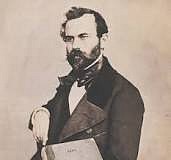BIOGRAPHY

1813-1889
Édouard-Denis Baldus was a French landscape, architectural and railway photographer. He was originally trained as a painter and had also worked as a draughtsman and lithographer before switching to photography in 1849.
Baldus was well known throughout France for his efforts in photography. One of his greatest assignments was to document the construction of the Louvre museum. He used wet and dry paper negatives as large as 10x14 inches in size. From these negatives, he made contact prints. In order to create a larger image, he put contact prints side by side to create a panoramic effect. He was renowned for the sheer size of his pictures, which ranged up to eight feet long for one panorama from around 1855, made from several negatives.
Despite the documentary nature of many of his assignments, Baldus was inventive in overcoming the limitations of the calotype process. He often retouched his negatives to blank out buildings and trees, or to put clouds in white skies. For example, in his composite print of the medieval cloister of St. Trophime, in Arles (1851), he pieced together fragments of 10 different negatives to capture focus in depth in a panoramic view of the interior space and also render detail in the brightly-lit courtyard outside.
